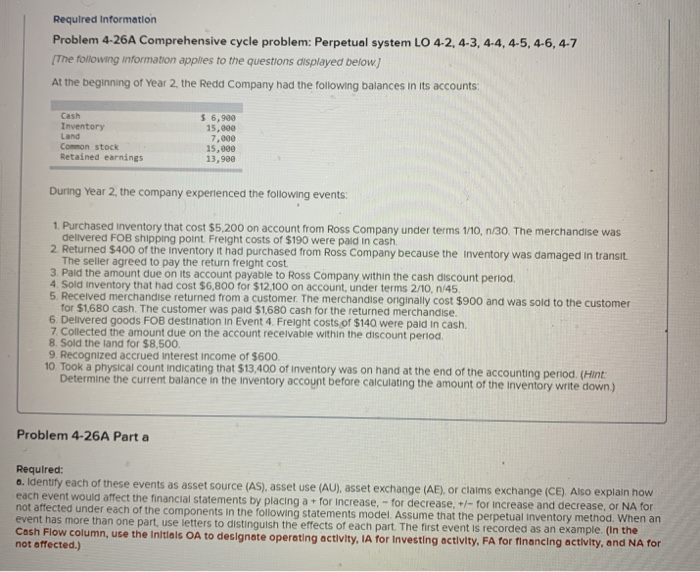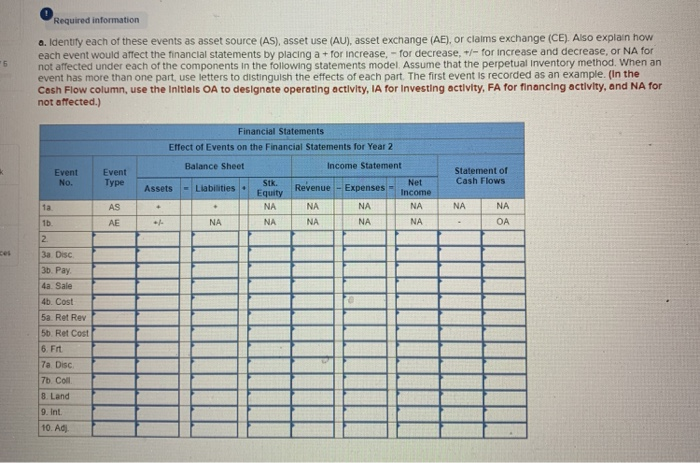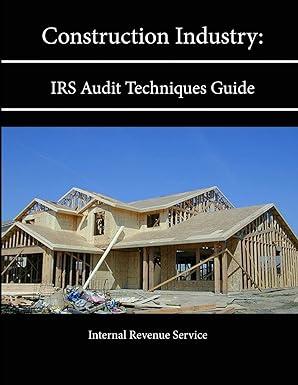Required Information Problem 4-26A Comprehensive cycle problem: Perpetual system LO 4-2, 4-3, 4-4,4-5, 4-6, 4-7 [The following information applies to the questions displayed below) At the beginning of Year 2, the Redd Company had the following balances in its accounts: Cash Inventory Land Common stock Retained earnings $ 6,900 15,000 7,000 15,000 13,900 During Year 2 the company experienced the following events: 1. Purchased inventory that cost $5,200 on account from Ross Company under terms 1/10,n/30. The merchandise was delivered FOB shipping point Freight costs of $190 were paid in cash. 2. Returned $400 of the inventory it had purchased from Ross Company because the inventory was damaged in transit. The seller agreed to pay the return freight cost. 3. Paid the amount due on its account payable to Ross Company within the cash discount period, 4. Sold Inventory that had cost $6,800 for $12,100 on account, under terms 2/10, 1/45 5. Received merchandise returned from a customer. The merchandise originally cost $900 and was sold to the customer for $1,680 cash. The customer was paid $1,680 cash for the returned merchandise 6. Delivered goods FOB destination in Event 4. Freight costs of $140 were paid in cash. 7. Collected the amount due on the account receivable within the discount period. 8. Sold the land for $8,500. 9. Recognized accrued interest income of $600. 10. Took a physical count indicating that S13,400 of inventory was on hand at the end of the accounting period. (Hint: Determine the current balance in the inventory account before calculating the amount of the inventory write down) Problem 4-26A Part a Required: a. Identify each of these events as asset source (AS), asset use (AU), asset exchange (AE), or claims exchange (CE). Also explain how each event would affect the financial statements by placing a + for increase, - for decrease, +/- for increase and decrease, or NA for not affected under each of the components in the following statements model. Assume that the perpetual inventory method. When an event has more than one part, use letters to distinguish the effects of each part. The first event is recorded as an example. (In the Cash Flow column, use the initials OA to designate operating activity, IA for Investing activity, FA for financing activity, and NA for not affected.) Required information 5 a. Identify each of these events as asset source (AS), asset use (AU), asset exchange (AE), or claims exchange (CE). Also explain how each event would affect the financial statements by placing a + for increase, - for decrease, +/- for increase and decrease, or NA for not affected under each of the components in the following statements model. Assume that the perpetual Inventory method. When an event has more than one part, use letters to distinguish the effects of each part. The first event is recorded as an example. (In the Cash Flow column, use the initials OA to designate operating activity, IA for Investing activity, FA for financing activity, and NA for not affected.) Financial Statements Effect of Events on the Financial Statements for Year 2 Balance Sheet Event No. Event Type Statement of Cash Flows Assets - Liabilities Income Statement Revenue Net Expenses Income NA NA NA NA NA NA Stk. Equity NA NA Ta . NA AS AE NA 1b NA 2 3a Disc 3b. Pay 4a. Sale 4b. Cost 5a. Ret Rev 5b. Ret Cost 6. Frt 7a Disc 7b Coll 8. Land 9. Int. 10. Ad








